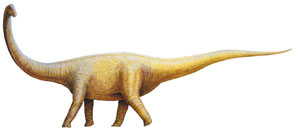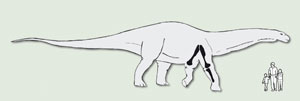Largest dinosaur bones in Australia discovered
Largest dinosaur bones in Australia discovered
Queensland Museum
May 3, 2007
The largest bones of any dinosaur known in Australia went on display at the Queensland Museum for the first time today.
Arts Minister Rod Welford said the internationally-significant fossils were the first dinosaur discovery in south-west Queensland and further excavations could uncover more.
“These two newly discovered dinosaur giants, nicknamed Cooper and George, were discovered near the town of Eromanga, 320km west of Charleville in November 2005 and April last year,” Mr Welford said.

|
“They are titanosaurs, which are plant-eating dinosaurs with extremely long necks and tails, massive bodies and elephant-like legs.”
Titanosaurs are the largest land-dwelling animals ever identified and their fossils have been found in rocks of similar ages and geographic regions around the world that once made up Gondwana, including South America and North Africa.
Cooper and George are thought to be of a new species of the titanosaur group that lived more than 95 million years ago.
Curator of Geosciences at the Queensland Museum, Scott Hocknull, said Cooper and George were at least 6-7m longer than another well-known Queensland sauropod, Elliot, previously the largest bone of any dinosaur found in Australia.
“Cooper’s right humerus weighs 100kg and is a rare complete bone measuring 1.5m in length,” Mr Hocknull said.
The new fossil-rich sites are part of the Winton Formation, a large sequence of rocks from the age of the dinosaurs, which spans Queensland’s interior.
At least seven sites have been identified from hundreds of bone fragments since the first fossil was uncovered in 2004. Many more sites on the property near Eromanga are still to be excavated.
Queensland Museum in conjunction with the Cooper/Eromanga Basin Natural History Society, which is sponsored by Santos, will conduct further excavations at the site in mid to late May.
The new dinosaur bones are on display now at the Queensland Museum exhibition Museum Zoo, currently on level 3 of the museum at South Bank.
This is a modified news release from the Queensland Museum
